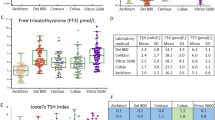Abstract
Objective: To assess the usefulness of the molar ratio of serum retinol-binding protein (RBP) to transthyretin (TTR) to determine vitamin A (VA) status during infection.
Design: We took advantage of previously collected data during a randomised double-blind, placebo-controlled clinical trial to conduct a secondary analysis of the RBP/TTR ratio and its relationship to infection and VA status. In this clinical trial, children were randomly assigned to one of three groups and received either one single oral high dose of VA (200 000 IU) on the day of admission and subsequently a placebo daily until discharge or daily oral low doses of VA (5000 IU) from admission until discharge or a placebo daily from admission until discharge.
Setting: Lwiro pediatric hospital, Province of South Kivu, Democratic Republic of Congo.
Subjects: A total of 900 children aged 0–72 months hospitalised consecutively between March 1994 and March 1996.
Main outcome measures: RBP/TTR molar ratio after 7 days hospitalisation.
Results: After 7 days hospitalisation, molar RBP:TTR ratio (mean±s.d.) of infected children (C-reactive proteins>10 mg/l) was 0.67±0.31 in the high-dose group (n=81), 0.74±0.44 in the low dose group (n=71) and 0.73±0.39 in the placebo group (n=81). These values did not differ significantly (one-way ANOVA P=0.472). In patients with baseline serum retinol concentrations<0.70 µmol/l, changes in RBP:TTR ratio between admission and day 7 were not statistically different in the three groups (one-way ANOVA P=0.548).
Conclusions: In this population of malnourished hospitalised children, molar RBP:TTR ratio does not appear to be useful to assess VA status during infection.
Sponsorship: Our research was partially supported by a grant from the Fonds de la Recherche Scientifique et Médicale (contract 3.4505.94) and the David and Alice Van Buuren Foundation.
European Journal of Clinical Nutrition (2001) 55, 1043–1047
This is a preview of subscription content, access via your institution
Access options
Subscribe to this journal
Receive 12 print issues and online access
$259.00 per year
only $21.58 per issue
Buy this article
- Purchase on Springer Link
- Instant access to full article PDF
Prices may be subject to local taxes which are calculated during checkout
Similar content being viewed by others

References
Beaton GH, Martorell R, Aronson KJ, Edmonston B, McCabe G, Ross AC & Harvey B (1993) Effectiveness of vitamin A supplementation in the control of young child morbidity and mortality in developing countries. (Discussion paper no. 13) Geneva: United Nations Administrative Committee on Coordination/Subcommitte on Nutrition State of the Art Series Nutrition Policy
Conners H, Gertz MA, Skinner M & Cohen AS (1984) Nephelometric measurement of human serum prealbumin and correlation with acute phase CRP and SAA J. Lab. Clin. Med. 104 538–545
Donnen Ph, Dramaix M, Brasseur D, Bitwe R, Vertongen F & Hennart Ph (1998) Randomized placebo-controlled clinical trial of the effect of a single high-dose or daily low-doses of vitamin A supplementation on morbidity of hospitalized malnourished children Am. J. Clin. Nutr. 68 1254–1260
Filteau SM, Morris S, Abbott RA, Tomkins A, Kirkwood BR, Arthur P, Ross DA, Gyapong JO & Raynes JG (1993) Influence of morbidity on serum retinol of children in a community-based study in northern Ghana Am. J. Clin. Nutr. 58 192–197
Ingenbleek Y & Young V (1994) Transthyretin (prealbumin) in health and disease: nutritional implications A. Rev. Nutr. 14 495–533
Norusis MJ (1990) SPSS Statistical Data Analysis Chicago, IL: SPSS Inc
Peterson PA, Nilsson SF, Östberg L, Rask L & Vahlquist A (1974) Aspects of the metabolism of retinol-binding protein and retinol In: Vitamins and Hormones, ed. RS Harris, PL Munson, E Diczfalusy & J Glover Vol 32 pp 181–214 New York: Academic Press
Rosales FJ & Ross AC (1998a) A low molar ratio of retinol binding protein to transthyretin indicates vitamin A deficiency during inflammation: studies in rats and a posteriori analysis of vitamin A-supplemented children with measles J. Nutr. 128 1681–1687
Rosales FJ & Ross AC (1998b) Acute inflammation induces hyporetinemia and modifies the plasma and tissue response to vitamin A supplementation in marginally vitamin A-deficient rats J. Nutr. 128 960–966
Samba C, Galan P, Luzeau R & Amedée Manesme O (1990) Vitamin A deficiency in pre-school age Congolese children during malarial attacks. Part 1: utilisation of the impression cytology with transfer in an equatorial country Int. J. Vitam. Nutr. Res. 60 215–223
Sommer A & West KP (1996) Vitamin A Deficiency. Health, Survival and Vision New York: Oxford University Press
Soprano D & Blaner WS (1994) Plasma retinol-binding protein In: The Retinoids, ed. MB Sporn, AB Roberts & DS Goodman, 2nd edn pp 257–281 New York: Raven Press
Turnham DI & Singkamani R (1991) The acute phase response and vitamin A status in malaria Trans. R. Soc. Trop. Med. Hygiene 86 194–199
Underwood BA (1994) Vitamin A in human nutrition: public health considerations In: The Retinoids, ed. MB Sporn, AB Roberts, DS Goodman, 2nd edn pp 211–227 New York: Raven Press
Vanderpas J & Vertongen F (1985) Erythrocyte vitamin E is oxidized at a lower peroxide concentration in neonates than in adults Blood 66 1272–1277
WHO (1982) Control of vitamin A deficiency and xerophthalmia Report of a joint WHO/UNICEF/USAID/Helen Keller International IVACG meeting. WHO Technical Report Series, no. 672 Geneva: WHO
WHO (1995) Global prevalence of vitamin A deficiency MDIS Working Paper no. 2. (WHO/NUT/95.3) Geneva: WHO
WHO (1996) Indicators for assessing vitamin A deficiency and their application in monitoring and evaluating intervention programmes Geneva: WHO
Author information
Authors and Affiliations
Corresponding author
Rights and permissions
About this article
Cite this article
Donnen, P., Dramaix, M., Brasseur, D. et al. The molar ratio of serum retinol-binding protein (RBP) to transthyretin (TTR) is not useful to assess vitamin A status during infection in hospitalised children. Eur J Clin Nutr 55, 1043–1047 (2001). https://doi.org/10.1038/sj.ejcn.1601271
Received:
Revised:
Accepted:
Published:
Issue Date:
DOI: https://doi.org/10.1038/sj.ejcn.1601271


